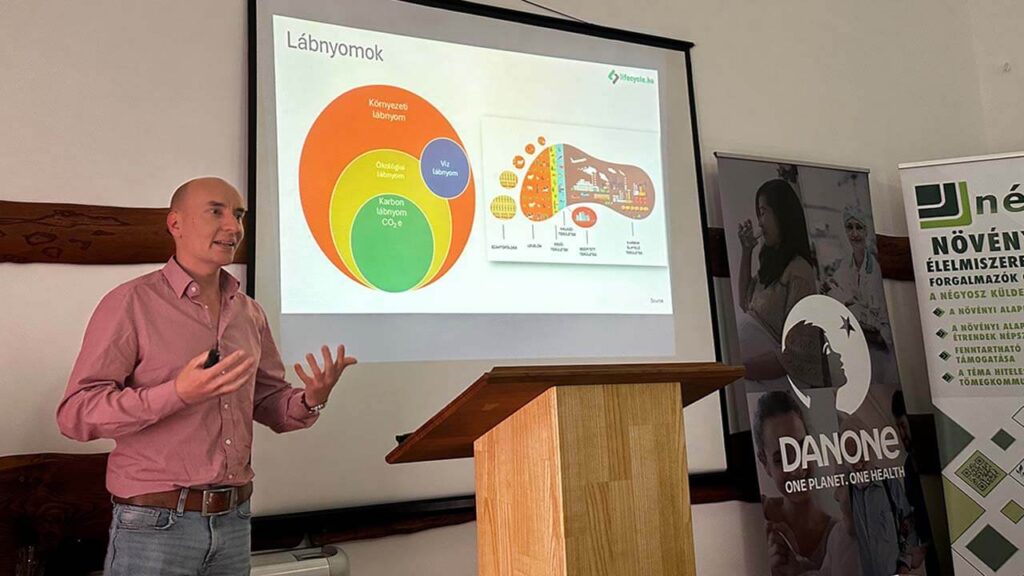
From Drought to Flood – How Plant-Based Foods Aid the Adaptation of the Hungarian Food Industry
Our organization held a workshop with this title on October 17th at the Magnet Community House. The event emphasized that supporting plant-based foods is not just an environmental issue but a strategic step toward increasing the resilience and adaptability of the Hungarian food industry. In the face of climate challenges, developing sustainable and innovative solutions is essential for future generations.
We invited government officials, representatives of organizations related to the food industry and nutritional science, dietitians, chefs promoting plant-based diets, and other professionals. Over 40 guests explored this highly multifaceted yet converging topic through 7 presentations and a collaborative workshop. The event was made possible with the support of Danone.
In our summary article, we aim to gather the most important thoughts into a bouquet.
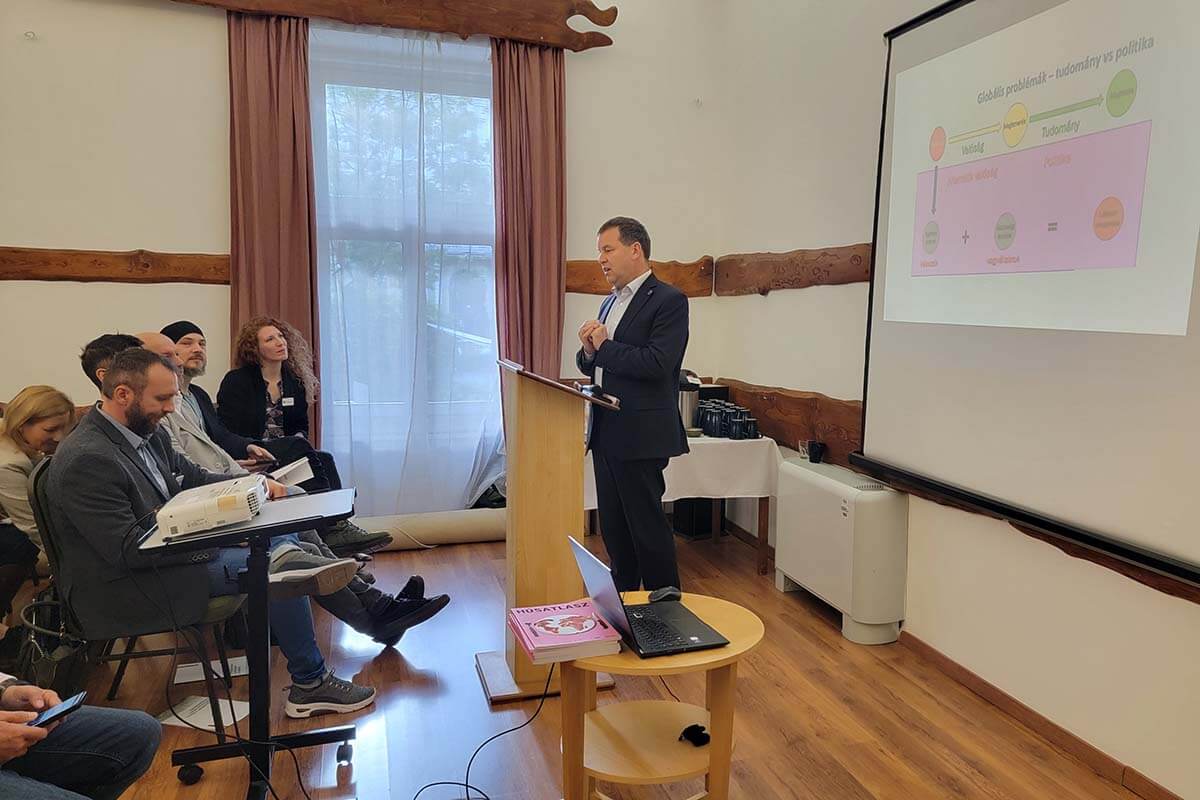
Green transition with oversimplified messages and ineffective solutions?
Dr. András Gelencsér, an atmospheric chemist, academician, and professor at the University of Pannonia, delivered a presentation on the illusion of the green transition. He emphasized that political communication often simplifies complex problems into “one-bit messages” that are easy to understand but do not reflect the real situation, leading to distorted remedial measures. While reducing CO2 emissions is important, the functioning of nature is more complex than that. A worrisome sign that we might not be heading in the right direction is that, despite measures aimed at reduction, emissions have increased according to 2023 data, and the proportion of fossil fuels has only been reduced by 3% over 44 years. The battery and hydrogen revolution may not provide a solution either, as the number and capacity of electric transportation devices are limited, and large-scale production of hydrogen is not realistically feasible.
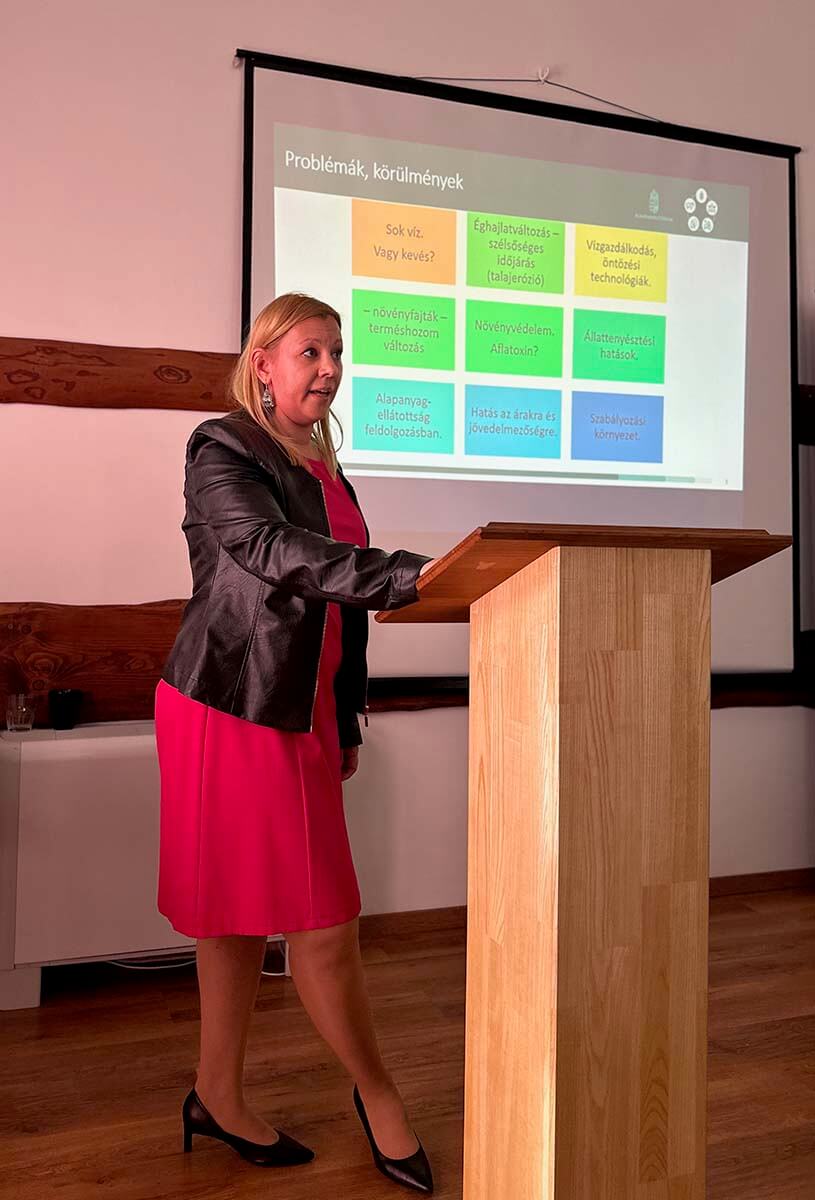
Drought Effects and Sustainability in the Food Industry
Hungary shapes its sustainability plans based on the regulations of the European Union. However, in her presentation titled Drought Effects and Sustainability in the Food Industry, Dr. Beáta Olga Felkai, Deputy State Secretary responsible for the food chain at the Ministry of Agriculture, revealed that the guidelines often arrive late or not at all. The Deputy State Secretary pointed out that the country’s agriculture has been severely affected by droughts and floods, and although the average water supply is abundant, distribution is problematic; 90% of our main agricultural areas have difficult water supply. Due to changes in the weather, it would be worthwhile to switch to cultivating new plant species. Change does not necessarily mean a narrowing palette. As an example, she mentioned kiwi brandy, since pálinka can only be made from fruits grown domestically, and Hungarian kiwi is already being produced. Change is necessary; new perspectives are opening up before us—we just need to adapt.
What Is the Ministry of Agriculture Doing in Terms of Sustainability?
The Deputy State Secretary called the plans for sustainability measures in the food industry developed by the European Commission “ambitious,” but in many cases, delays or omissions are experienced when the regulations are implemented. Improving animal welfare is among the plans, but concrete steps have so far mainly been limited to the transport of livestock and to dogs and cats. Currently, the main task is resource generation. She also mentioned food waste as an important topic, which involves significant greenhouse gas emissions; at the same time, she observes that in the HoReCa sector (Hotels, Restaurants, Cafés), more and more environmentally friendly initiatives (e.g., biodegradable packaging, more sustainable transportation) are appearing.
Within the framework of the Common Agricultural Policy (CAP) strategic plan, the role and place of plant-based foods regularly arise. According to Dr. Beáta Olga Felkai, the Ministry of Agriculture ensures that these products are not disadvantaged in regulations and tender announcements. Recurring questions include taxation (Public Health Product Tax), whether plant-based foods should have a larger proportion in public catering, and whether consumers really want or need this. They try to “cut off” extreme opinions, but if there is a development or regulatory need, they are open to addressing it.

An attendee was curious whether, noticing that there are European Union countries significantly ahead in the proliferation of plant-based foods, Hungary is considering creating a comprehensive plant-based strategy. This strategy would encompass everything from farmers and processors to public caterers and commerce, including mentioning VAT reduction, covering the entire spectrum.
The Deputy State Secretary stated that if they receive an initiative or material upon which this can be prepared, they are naturally open to it. They observe the increasing number of initiatives. They consider the establishment of NÉGYOSZ as a step in this direction, and they have invited and continue to invite its executive director, István Miskolczi, for consultations on numerous occasions, and hereby thank him for his cooperation.
NÉGYOSZ would like to see a plant-based strategy in Hungary. To support the spread of plant-based nutrition in Hungary, we have outlined the necessary measures in four points in the Plant-based Manifesto.
Another attendee raised an interesting topic, asking whether Hungary is open to methods outside the EU, particularly in solving water supply problems using artificial intelligence, which a water-scarce country like India uses successfully. Dr. Beáta Olga Felkai said she would inquire with the Ministry of Innovation, but it is unlikely they will give the opportunity to choose from many new possibilities. She also alluded to the lack of funds, noting that while this was a significant factor in India as well, they still managed to find solutions.
Climate change impacts on food production and prices
Climate and all kinds of environmental impacts and changes will sooner or later be transformed into food prices, and these impacts will become more frequent, so that the impact on agriculture and food prices will escalate. This was already stated by Zombor Berezvai, Associate Professor at Corvinus University and Head of the Office for Competition Economics and Market Research of the Hungarian Competition Authority in his presentation on the impact of climate change on food production and prices.
Contrary to government communication, Zombor believes that Hungarian agriculture is dependent on imports for many necessary inputs (e.g. petroleum, fertilisers, pesticides). So, in fact, the effects of higher prices are filtering through to Hungary even as it strives for self-sufficiency.

According to EU data for 2022, there has been a significant price increase in the price of raw milk, and vegetable drinks such as rice drinks have moved closer to the price of cow’s milk. This indicates that crop products are more resistant to price effects. He cited the example of an Alpro oat drink, which has been priced the same in the DM webshop since September 2022. According to Central Statistical Office data, the price of cow’s milk has risen by an average of 8% over this period.
Why can crop prices be more stable?
The impact of weather on prices depends on the size of the land and technological developments. Crop prices can be more stable because they are less dependent on changes in commodity prices. There is less exposure because it takes less raw material to produce, for example, a litre of soya milk than a litre of cow’s milk. This also means that production in the most disadvantaged areas is not needed. We can give areas back to nature. And even if yields fall, there will not be a big price impact, because we can reduce demand overall, which balances out the fact that demand for these products is increasing globally. This allows us to reduce production in the event of adverse environmental impacts without a drastic price increase. Furthermore, there is still considerable scope for improvement in the production of crop products, while the meat and dairy industries are more mature. This could also help to reduce prices for consumers by improving economies of scale, as seen for example in the case of Lidl, where prices for plant-based products are the same as for conventional animal-based products.
It is also politically advantageous if food prices are not so dependent on environmental impacts and cannot swing to extremes. In Western Europe, if not in Hungary, many governments have had a difficult time with the rising cost of food, and this is reflected in the support of voters for their governing parties.
In response to a question from viewers, Zombor said it was true that cow’s milk requires 14 times the land area to produce compared to plant-based drinks, and while plant-based drinks can be a functional substitute for cow’s milk, their nutritional value is different. Soy drinks have a similar nutritional value to cow’s milk, while oat and rice drinks require the addition of vitamins. The environmental burden of adding vitamins is difficult to assess, but it is not significant and plant-based remains more sustainable than animal milk.
In the UK, a study was done looking at what foods people with vegan, vegetarian and other diets eat and then looking at the environmental impact of these products based on a life cycle analysis. The main conclusion is that it is really the amount of meat you eat that matters. The less, the more sustainable the diet. Whether you replace meat with avocados or wheat has no effect on the outcome.

Environmental footprint of food, how do we calculate it and why?
Artúr Szilágyi, Research Engineer, Life Cycle Analysis, presented in his presentation entitled “The limits of our planet, we have crossed the limit in 6 out of 9 – The environmental footprint of food, how do we calculate it and why?”, the 9 critical factors that determine the health of planet Earth, of which only 3 are within the sustainable limit. He explained that the environmental footprint, ecological footprint, water footprint and carbon footprint are not the same. The environmental footprint includes all of them. The environmental footprint of an average EU citizen is made up of 16 components. Food has the biggest impact on almost all environmental problems.
On the environmental impact of food, he stressed that we should choose food from sustainable sources, but that it is difficult to find truly sustainable products in shops. For example, the environmental burden of producing plastic packaging is much lower than the environmental burden of the raw materials and the food itself, so avoiding packaging is not always the answer. For example, why snake cucumbers are packed in plastic piece by piece, a study has shown that the emissions from plastic packaging are a fraction of those from cucumber production.
NÉGYOSZ’s position is that there is no reliable data on how many cucumbers would be damaged and become unsaleable without packaging, increasing food waste.

The protein transition in Europe
Developing alternative protein sources is not only a technological innovation, but also a potential answer to the environmental and social problems we face. István Miskolczi, Executive Director of NÉGYOSZ, gave a presentation on “Protein transition in Europe: how plant-based diets are transforming the food industry”, in which he described what is currently happening in Europe in the field of protein transition. At European level, alternative protein sources typically refer to 3 types of things: plant-based protein sources, protein from materials transformed by precision fermentation, and meat alternatives produced by cell culture. NÉGYOSZ believes that we are still a long way from the realistic introduction of cultured meat, but that mycelial fermentation, where fungal lines convert a feed into protein, could realistically be a marketable product within 2-5 years.
What is missing in Hungary, what would be needed?
There are good examples of regulation of plant-based products in Europe. In Denmark, a fund of €185 million was set up in 2022 to support plant-based products, and in 2023 a plant-based action plan was built, which, whether there is money or not, will definitely point the way. France is promoting the consumption of pulses as an alternative source of protein, the UK has set up a fund to look at everything with a low environmental footprint, and Ireland has launched a wonderfully large initiative to develop additives using fermentation technology to add better taste and texture to plant-based foods.
Germany is an excellent example, with €38 million to support the protein transition, and this is not just for the promotion, development and production of plant-based products, €20 million of this is specifically for farmers and growers. In the Czech Republic, VAT on plant-based drinks has been brought on a par with conventional milk. Germany, the United Kingdom and the Netherlands have launched a very substantial research project to breed cell-based meat alternatives. Austria, Sweden, Finland and again the UK are putting a strong emphasis on fermentation.
According to the Strategic Dialogue on the future of EU agriculture, the time for change has come and collaboration in the food value chain is essential. Coherent policy measures are needed to achieve synergies. To achieve these goals, governments, civil society, business and international organisations need to work together.
Hungary does not yet have such regulation, support, a transition fund and we are not at the forefront of innovation. But we still have super companies and very good initiatives in the area of plant-based products. But in fermentation and cell-cultured meat, we do not know of anybody who is involved in such a project. European countries have already started, following some kind of strategy, using technology, and they are definitely moving forward. The Manifesto, which has been drawn up by NÉGYOSZ, could be the next step as a national plant strategy and could guarantee our country’s commitment in some direction.
On the subject of VAT, most EU countries have begun to bring the VAT rate on plant foodstuffs at least up to the level of the EU average. According to NÉGYOSZ, plant-based foods should be made available in public catering, schools and hospitals. It is important that this is a concerted effort, because if we all start pulling in our own direction, nothing will change and no progress will be made.
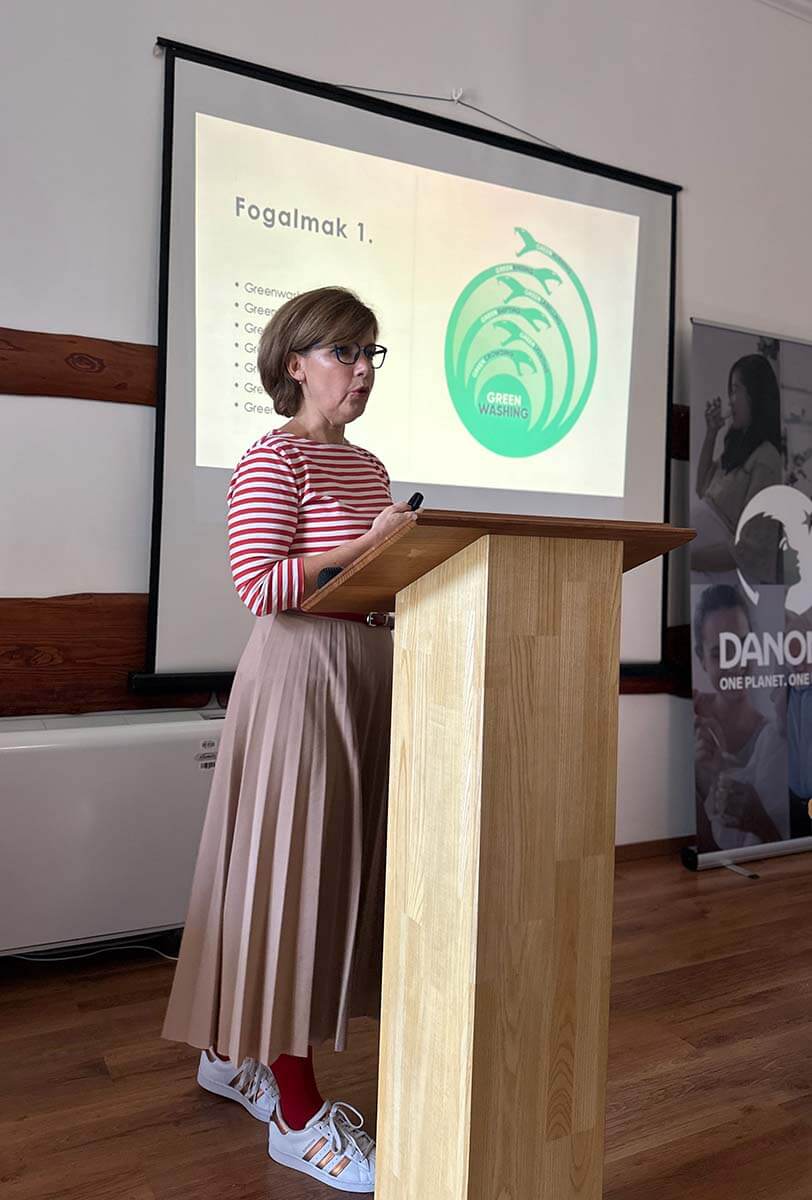
Green communication in the food industry
In Hungary, we live in a punitive culture, which means that changes are usually only made when there is a threat, said Réka Szöllősi, an independent food policy analyst, in her opening presentation. Since the Sustainability Report became mandatory, many companies have started to engage in green communication, but they can only do so in a modern and legal way if they are aware of their own sustainability impacts, including environmental, social and nutritional aspects. Companies should communicate in areas where they can have the greatest green impact. They need to know their full environmental impact in order to make environmental claims to consumers.
Green communication also includes what companies are hiding. Consumers often believe that products with green packaging are environmentally friendly, when the environmental impact of the packaging dwarfs that of the product, so not all ‘green’ packaging is actually behind a green product.
Greenwashing can cause significant economic damage, as the financial sector can misprice corporate operations and securities as green, which can have a knock-on effect on the economy. Transparency is important, companies need to make their messages, based on numbers and data, available to consumers. Two pieces of EU legislation address this, but with new regulations now expected, companies will not be able to claim to be green without real measurements.
New nutritional recommendations
Barbara Bíró Lovasné, food expert and secretary of the Responsible Food Producers Association (FÉSZ), said in her presentation on New Nutrition Recommendations that the written, data-driven, nutrient-centred approach to nutrition recommendations has now evolved to include graphical, infographic food recommendations, which are easier to understand and interpret for the less knowledgeable.
By 2050, the world is expected to have 9 billion people, doubling the demand for protein, while climate change and other factors threaten food security. It is important to take active action against hunger and malnutrition. These are not problems for the future, but for the present, affecting some 800 million people.
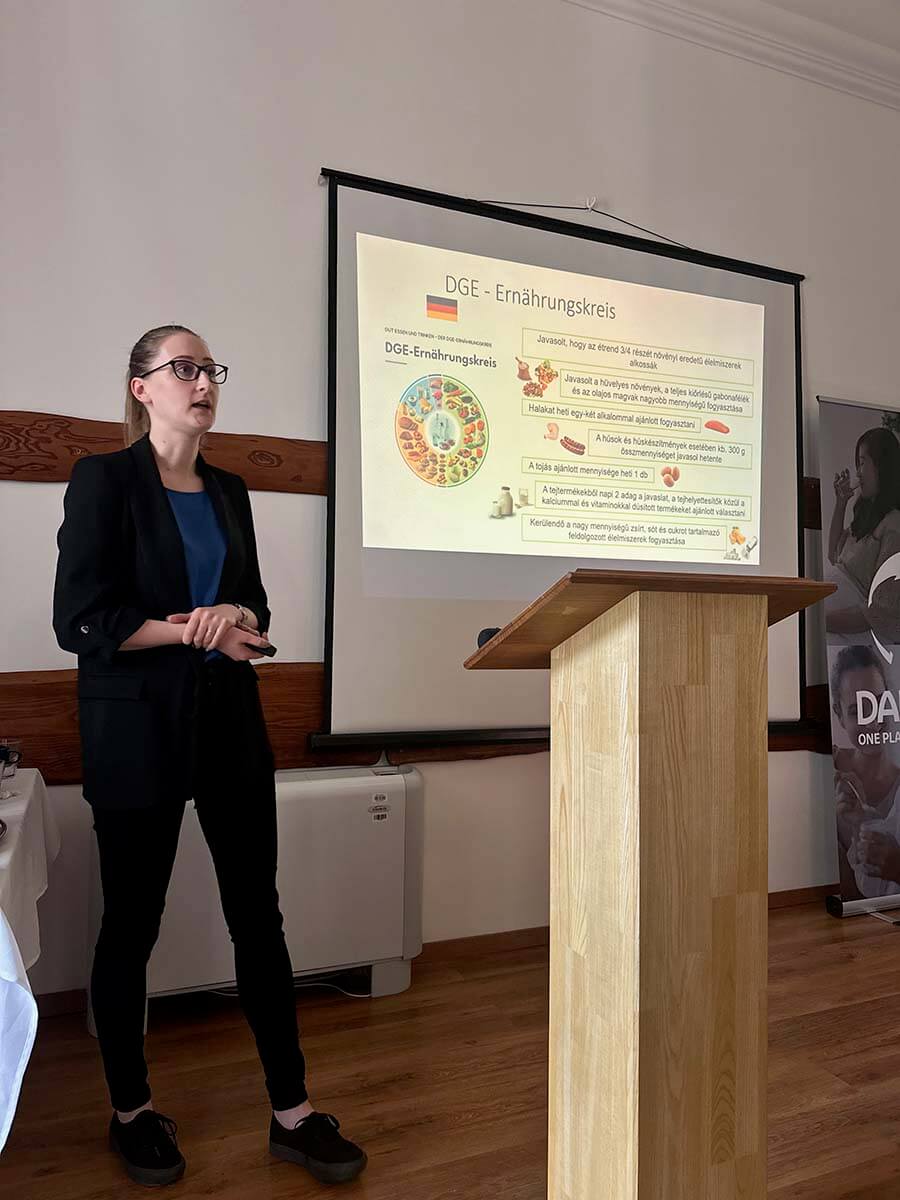
The EU is pushing its Member States to take sustainability into account when developing dietary recommendations. Summarising the renewed dietary recommendations from Germany, Austria and the Nordic countries, none of the recommendations say to completely abandon animal-based foods, but they all stress eating more vegetables, fruit, pulses and whole grains. Choose good quality, local animal products and minimise processed foods high in salt, sugar and fat.
In addition, the importance of exercise and rest, as well as the experience of eating and preparing food, are also highlighted in all three recommendations. Perhaps these should no longer be called nutritional lifestyle recommendations, but also sustainability recommendations, as they encompass so much.
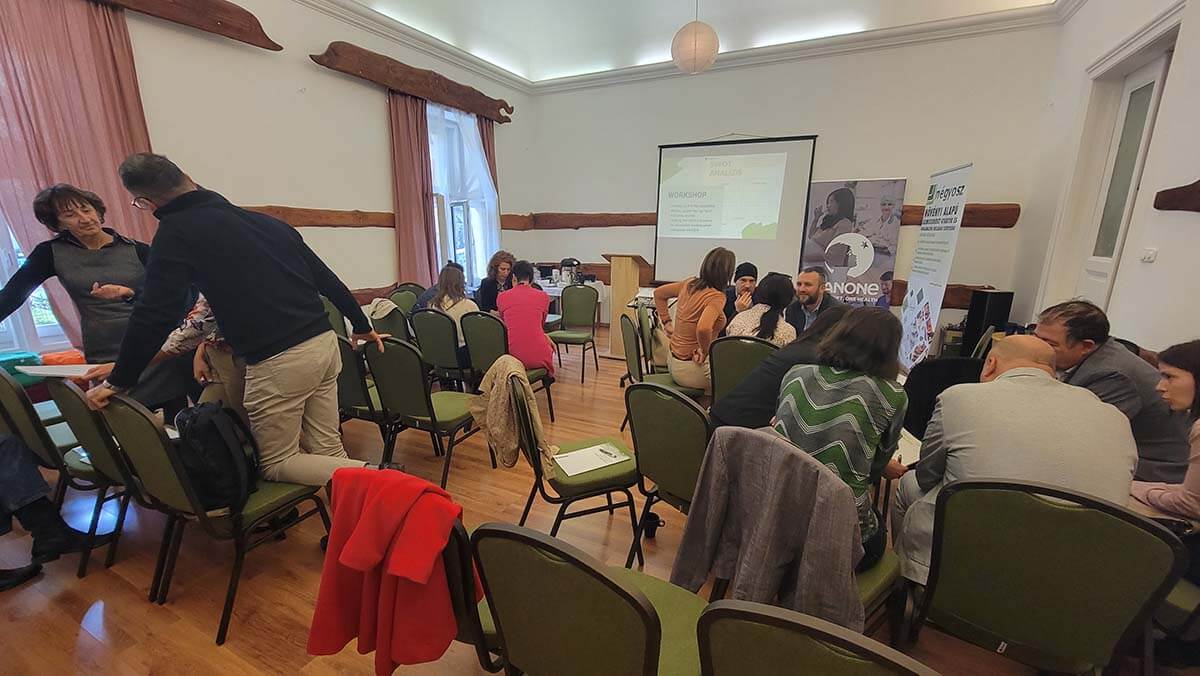
Workshop: SWOT analysis
A How can the expansion of plant-based diets contribute to the sustainability of the food industry and climate change mitigation in Hungary? we had the participants form teams and prepare a SWOT analysis along the main question. 5 teams enthusiastically analysed the situation and compiled the Strengths, Weaknesses, Opportunities, Threats and formulated Conclusions. The group analysis of the results was shared with the participants afterwards.